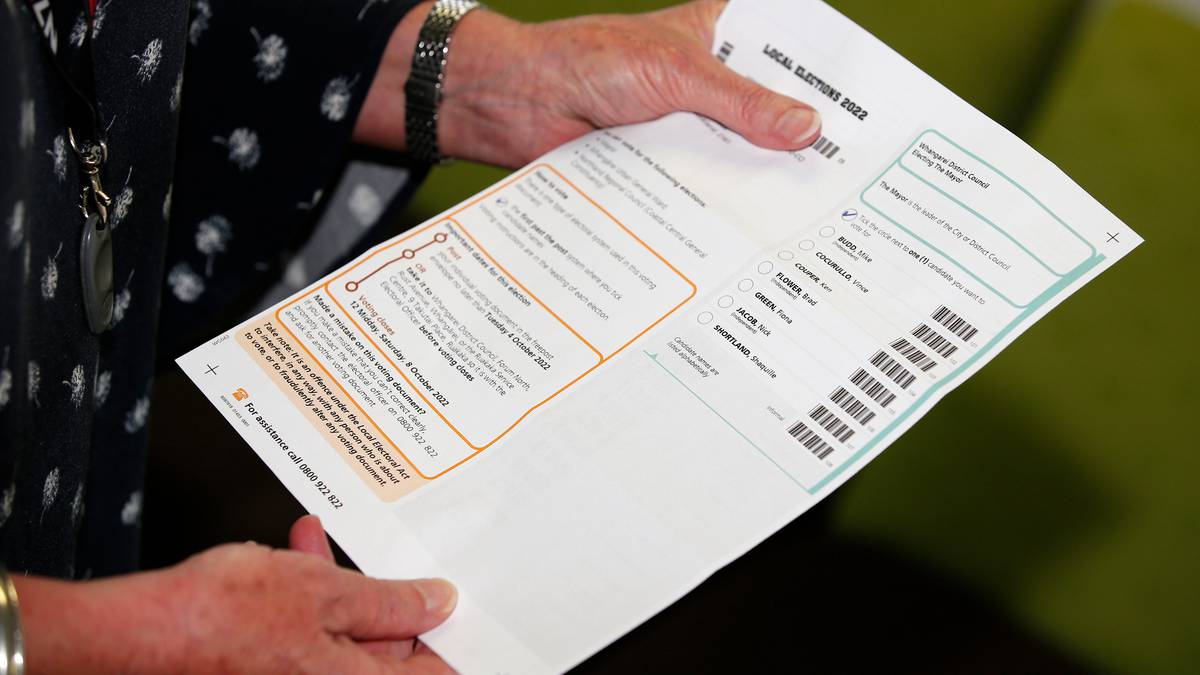Local election paper voting is an outdated 19th century approach, says Whangārei Mayor Sheryl Mai. Photo / Michael Cunningham
Whangārei Mayor Sheryl Mai says the Government has failed New Zealanders by not bringing in electronic voting for the 2022 local elections – as voter returns to date plummet.
Northland’s 2022 local election voting returns are tracking well below previous elections.
Three times fewer Far North District Council (FNDC) voters had their votes lodged by Wednesday, September 28 than at the same point in the voting period for the 2016 local elections.
Half the number of Whangārei District Council (WDC) and Kaipara District Council (KDC) voters had lodged their votes by Wednesday compared with the same point in the voting process in the 2016 local elections.
The pace of triennial local election voter returns has fallen steadily for all councils since 2016.
By Wednesday this week just 9 per cent of WDC voters had lodged their votes. This compared with 17.2 per cent of voters in 2019 and 19 per cent in 2016.
/cloudfront-ap-southeast-2.images.arcpublishing.com/nzme/NNP2P44QGGQWALD7UDXRSHEUH4.jpg)
KDC voters had returned just 11.1 per cent of their votes by Wednesday this week, compared with 17.7 per cent in 2019 and 21.8 per cent in 2016.
FNDC voter return patterns were slightly different over these three elections. On Wednesday, September 28 this year 6.5 per cent voters had their votes in. This compares with only 2.2 per cent in 2019 but 20.6 per cent of voters in 2016.
KDC topped Northland’s three district council voter returns by Wednesday this week followed by WDC then FNDC, which were the lowest of Northland’s four councils including Northland Regional Council (NRC). NRC voters had returned 8.4 per cent of their votes by Wednesday this week. Comparative voter returns at the same date for 2016 and 2019 were not available at edition time.
Mai said electronic voting should have been brought in for New Zealand’s 2022 local elections to boost flagging voter numbers.
She said voting on a paper form and putting it through the post was a 19th century system. It was alien to young people in particular.
Mai said she hoped the Government would bring in electronic voting for the next local elections.
Meanwhile Mai said it was crucial Northlanders voted in the 2022 local elections.
“Get off your chuff and vote,” Mai said.
She said it was important local people contributed to local democracy.
Mai said total overall voting had been declining for a number of years. The lower returns for 2022 voting date indicated this decline would likely speed up.
Massey University local government specialist Dr Jeff McNeill, a senior lecturer at the School of People, Environment and Planning, said Covid-19 was a likely contributor to this year’s voter return pace decline.
McNeill said the world had changed since Covid 19 arrived in New Zealand in February 2020, just four months after the previous 2019 elections.
Many people were still more inward-looking than previously.
McNeill said Northlanders should exercise their right to vote locally, an option not available for many people around the world.
“I’ve got friends from Eastern Europe who fought for the right to be able to vote.”
He said Northland’s slowed voter returns were being echoed around New Zealand.
Voter returns tended to be higher where there was an issue of concern to the local community, McNeill said.
Northland’s highest voter returns until Wednesday this week were in KDC’s Kaiwaka-Mangawhai General Ward where ongoing echoes of the past Mangawhai sewerage scheme cost blowout, ratepayers refusing to pay rates as a result and commissioners running the council for several years are still reverberating.
Voter returns for this ward sat at 15.1 per cent by Wednesday this week. Mangawhai is also in NRC’s Coastal South General Constituency which tops regional council constituency returns at 12.8 per cent.
Voters have until October 8 at noon to vote for Northland’s three mayors, 41 councillors or 19 community board members from among 191 candidates.
The candidates are made up of 22 would-be mayors, 136 would-be councillors and 33 would-be community board candidates. Thirty-two Māori ward candidates are vying for nine seats across Northland’s four councils among these numbers.
The numbers
Council general ward voting returns:
For WDC, general wards’ ranked voter returns were Whangārei Heads General Ward 12.1 per cent, Bream Bay General Ward 11.9 per cent, Mangakahia-Maungatapere General Ward 9.6 per cent, Hikurangi-Coastal General Ward 8.9 per cent and Whangārei Urban General Ward 8.5 per cent.
For FNDC, general wards’ ranked voter returns were Te Hiku General Ward 8 per cent, Kaikohe-Hokianga General Ward 7.4 per cent and Bay of Islands-Whangaroa General Ward 6.3 per cent.
For KDC, general wards’ ranked voter returns were Kaiwaka-Mangawhai General Ward 15.1 per cent, Otamatea General Ward 10.7 per cent and Wairoa General Ward 9.4 per cent.
For NRC, general constituencies’ ranked voter returns were Coastal South General Constituency’s 12.8 per cent, Coastal Central General Constituency 10.2 per cent, Kaipara General Constituency 9.8 per cent, Whangārei Central General Constituency 8.5 per cent, Mid North General Constituency 8.1 per cent, Far North General Constituency 7.5 per cent and Bay of Islands-Whangaroa General Constituency 6.8 per cent.
Council Māori ward voting returns:
Voting returns until Wednesday this week for each of Northland’s four councils are lowest in their three new Māori electoral areas where they are tracking at between 4.1 per cent and 5.7 per cent.
WDC’s Whangārei District Māori Ward had a 5.7 per cent voter return, NRC’s Te Raki Māori Constituency 5.3 per cent, FNDC’s Ngā Tai o Tokerau Māori Ward 5.1 per cent followed by KDC’s Te Moananui o Kaipara Māori Ward 4.1 per cent.
• Local Democracy Reporting is Public Interest Journalism funded through NZ On Air





